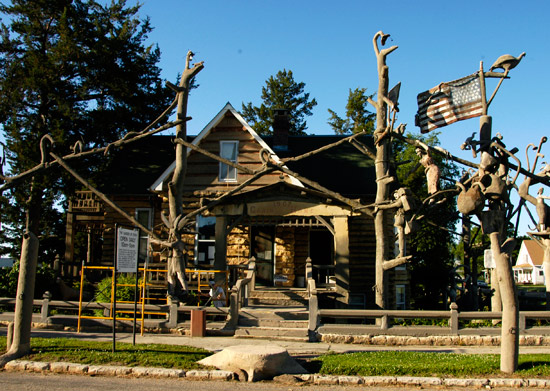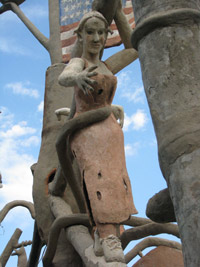In Kansas, the Wisconsin Idea drives a spectacular restoration

The Garden of Eden site in Lucas, Kan.
The 300 residents of Lucas, Kan., live in a windblown corner of the state too remote for cellphone service. In this isolated community, trees were so rare that resident Samuel P. Dinsmoor built his cabin-style home out of fencepost limestone “logs” more than 20 feet long.
Out of this barren landscape, Dinsmoor created his Garden of Eden: More than 150 handmade sculptures telling countless stories about religion, populism and America.
One of the earliest and best-known examples of grass roots or vernacular art environments, the Garden of Eden is listed on the National Register of Historic Places. But because of its remote location, its previous caretakers — including a University of Kansas professor living more than 200 miles away – found it difficult to maintain.
For seven weeks this summer, UW–Madison graduate student Emma Silverman got the hands-on experience of a lifetime as she helped conserve the site. These efforts have strengthened the bonds of a unique scholarly exchange between Wisconsin’s Kohler Foundation, the university and tiny Lucas itself.

A figure in front of the concrete American flag features eyes made from marbles and shoes tied with concrete strings.
A Civil War veteran, Dinsmoor began construction in 1904 at the age of 64, stopping only due to blindness 25 years later. Using more than 113 tons of concrete and pigments made from local, crushed stone, each of the sculptures has a meaning: commentaries on religion, civilization, the modern world and the people who live in it.
“Adam and Eve may speak to many people personally, but the political imagery is 80-90 years old and still felt very fresh,” says Silverman.
The condition of the sculptures themselves, however, needed work. Mold and dirt had discolored the pieces; chips of cement and ground rock flaked from the works and dulled the vivid colors. Dinsmoor’s experimental style precluded easy restoration.
Enter the Kohler Foundation. Already notable for its namesake campus library, the foundation’s relationship with the university grew.
“Kohler has been so significant to us,” says Ann Smart Martin, professor of art history and head of the material culture program. “They hosted a group of faculty and grad students at the very beginning of our program; we sat at the Waelderhaus [retreat center] and worked it out. I like to say we were born there.”
Known for its preservation of folk and vernacular art environments in Wisconsin, such as the Mary Nohl house outside of Milwaukee, the foundation leaped at the chance to preserve the “granddaddy” of grass roots sites. As it has done with multiple environments around Wisconsin, the foundation purchased the Garden of Eden just long enough to restore it, then give it back to its community caretakers.
“We’re saving some wonderful things – people can be inspired by it, share it,” says executive director Terri Yoho. “When you see this work, you know that there was a person there who was living their dream. That’s something you never get tired of.”
Silverman has loved vernacular art since visiting countless roadside attractions on cross-country road trips. Now, as a second-year master’s student, she uses her Kohler-funded fellowship to preserve these sites while gaining valuable hands-on experience.
“It’s affecting, moving, even if the person who created it isn’t present,” says Silverman. “I was looking at programs where I could integrate that interest, and UW–Madison had that sort of special relationship with the Kohler Foundation.”
During the school year, Silverman traveled back and forth to Kohler each Friday, working on various conservation projects.
“Emma’s impassioned about this kind of art,” says Yoho. “Through this relationship, we were able to get one of the last possible opportunities to get into an art environment in [New York’s] Chelsea Hotel before it closed. So we’re able to help open some doors that might not otherwise be opened.”
The experience has proven the value of a humanities degree, bridging the line between museum, gallery and market work. Silverman could use industry-standard cataloguing software; she could work with appraisers to catalogue pieces whose worth changed dramatically based on their place in a collection.
In Kansas, the physicality of the work added to its complexity. To replicate the pigments Dinsmoor used, the conservators chipped away colored stone, then ground the stone to mix it with concrete. Temperatures regularly topped 100 degrees. In Silverman’s most vivid memory, the group finished out one day by jumping into a cool lake.
“People would just wander up and tell us stories of their own experience with the Garden of Eden,” says Silverman. “Getting to live with it every day, we’d see little differences, like where the birds’ nests are. There’s a lot of reciprocal learning when you’re onsite like that.”
This powerful sense of place, in a community where the local paper lists out-of-town guests for Sunday dinner, underscored the importance of Silverman’s work.
“There’s this love – this is their identity, this little town! It was really touching,” recalls Martin. “Even at a restaurant 30 miles away, a woman got tears in her eyes when we told her what we were doing. That happened at least three times. It was just magical.”
Subscribe to Wisconsin Ideas
Want more stories of the Wisconsin Idea in action? Sign-up for our monthly e-newsletter highlighting how Badgers are taking their education and research beyond the boundaries of the classroom to improve lives.
Tags: arts, The Wisconsin Idea




